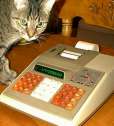Casio PB-220
| Datasheet legend
Ab/c:
Fractions calculation
AC: Alternating current BaseN: Number base calculations Card: Magnetic card storage Cmem: Continuous memory Cond: Conditional execution Const: Scientific constants Cplx: Complex number arithmetic DC: Direct current Eqlib: Equation library Exp: Exponential/log functions Fin: Financial functions Grph: Graphing capability Hyp: Hyperbolic functions Ind: Indirect addressing Intg: Numerical integration Jump: Unconditional jump (GOTO) Lbl: Program labels LCD: Liquid Crystal Display LED: Light-Emitting Diode Li-ion: Li-ion rechargeable battery Lreg: Linear regression (2-var. stats) mA: Milliamperes of current Mtrx: Matrix support NiCd: Nickel-Cadmium recharg. batt. NiMH: Nickel-metal-hydrite rech. batt. Prnt: Printer RTC: Real-time clock Sdev: Standard deviation (1-var. stats) Solv: Equation solver Subr: Subroutine call capability Symb: Symbolic computing Tape: Magnetic tape storage Trig: Trigonometric functions Units: Unit conversions VAC: Volts AC VDC: Volts DC |
| ||||||||||||||||||||||||||||||||||||||||||||||||||||||||
Casio PB-220
 The PB-220 from Casio looks like a calculator, but it's more than that: it is a BASIC-programmable handheld computer. Its internal memory is limited but, and this is not obvious at first sight, the machine is expandable: an internal expansion slot accepts an 8 kB memory card, bringing the total up to 10 kB.
The PB-220 from Casio looks like a calculator, but it's more than that: it is a BASIC-programmable handheld computer. Its internal memory is limited but, and this is not obvious at first sight, the machine is expandable: an internal expansion slot accepts an 8 kB memory card, bringing the total up to 10 kB.
Unusual among these machines is the presence of a label card window under the display. This is similar to old, magnetic card programmable calculators like the HP-65 where a slot was provided for the card, label side up, right above the five program keys A-E. The only other Casio machine that I know of with a similar feature is the unusual PD-310 and its non-programmable counterpart, the PD-300.
An input/output port allows the PB-220 to communicate with an external printer or storage device.
The following small BASIC program demonstates the calculator's programming model by computing the Gamma function using Stirling's approximation and a simple iteration for small or negative arguments:
10 INPUT X 20 G=1 30 IF X>5 THEN 70 40 G=G*X 50 X=X+1 60 GOTO 30 70 G=X*LOGX-X+LOG(SQR(2*π/X)/G) 80 G=G+((((1/99/X/X-1/140)/X/X+1/105)/X/X-1/30)/X/X+1)/12/X 90 PRINT G,EXPG


